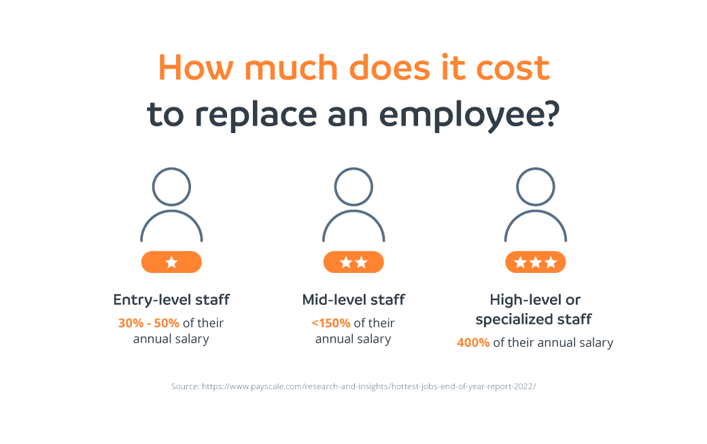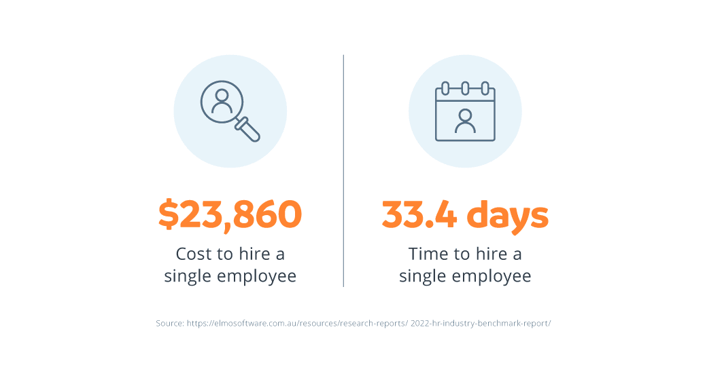75% of the reasons for employee turnover can be prevented1. Employee turnover is a common challenge that many businesses face. While some degree of turnover is normal and even healthy for an organization, high levels of turnover can be a cause for concern.

Not only does it disrupt team dynamics and reduce productivity, but it can also have significant financial implications for a business. In this blog, we'll take a closer look at employee turnover, its causes, costs and ways to avoid and deal with it.
What is employee turnover?
Employee turnover refers to the rate at which employees leave an organization and are replaced by new hires. It is a measure of the number of employees who leave a company over a given period of time, usually expressed as a percentage of the total workforce. High turnover rates can indicate that employees are dissatisfied with their jobs or the company and are leaving for better opportunities elsewhere.
What are the different types of employee turnover?
Understanding the different types of employee turnover can help organizations address the underlying reasons for employees leaving:
- Voluntary turnover: when an employee decides to leave the organization voluntarily, whether it's due to personal reasons, a better job offer or dissatisfaction with the current job or organization.
- Involuntary turnover: when an employee is terminated by the organization due to poor performance, misconduct or restructuring.
- Functional turnover: when low-performing or dissatisfied employees leave and are replaced by new hires who are expected to perform better.
- Dysfunctional turnover: when high-performing or valuable employees leave, resulting in a loss of knowledge, skills and experience for the organization.
Ways to measure employee turnover
In general, industries can expect an employee turnover rate of nearly 19%2. Measuring employee turnover is essential for organizations to identify trends and develop strategies to retain their employees:
- Separation rate: the number of employees who leave the organization divided by the average number of employees during a specific period.
- Turnover cost: the monetary cost associated with recruiting, hiring, and training new employees to replace those who have left.
- Retention rate: the percentage of employees who stay with the organization over a given period of time.
- Time-to-fill: the amount of time it takes to fill a vacant position with a new employee.
- Exit interview: a survey conducted with employees who are leaving the organization to gather feedback on their experience and reasons for leaving.
What causes staff turnover?
Employee turnover can be caused by a variety of factors, both internal and external to the organization. Some of the most common causes include:
Poor management
One of the main reasons for high turnover rates is poor management. When managers are not effective in their roles, employees may feel unsupported, undervalued or micromanaged. This can lead to low morale, high levels of stress and a lack of trust in the organization.
Lack of growth and development opportunities
Employees want to feel like they are growing and developing in their careers. When there are limited opportunities for growth within an organization, employees may become bored, disengaged and ultimately seek new opportunities elsewhere.
Compensation and benefits
Compensation and benefits play a significant role in employee retention. If employees feel that they are not being compensated fairly for their work or are not receiving the benefits they need, they may be more likely to leave the organization.
Work-life balance
In today's fast-paced work environment, work-life balance has become increasingly important to employees. When employees feel that they are constantly working and not able to enjoy their personal lives, they may become burnt out and seek opportunities elsewhere.
Work culture
The work culture of an organization can also play a significant role in employee turnover. When employees feel that they do not fit in with the culture or values of an organization, they may become disengaged and seek opportunities elsewhere.
How can you improve employee engagement?

How much does staff turnover cost?
Employee turnover is not only a significant challenge for organizations in terms of morale and productivity, but it can also be very costly.

Some of the costs, both financial and non-financial, associated with employee turnover include:
Trust issues
When employees leave an organization, it can create trust issues within the remaining workforce. Employees may feel uncertain about their job security, and trust in management may be eroded.
Recruitment costs
One of the most significant costs associated with employee turnover is recruitment costs.

Organizations must spend time and money recruiting and hiring new employees to replace those who have left. This can include advertising job openings, reviewing resumes, conducting interviews and running background checks.
Training costs
If recruits receive insufficient training, around 40% of them are likely to leave the company within a year of being hired3. Once new employees are hired, organizations must invest time and money in training them. This can include orientation, job-specific training and ongoing professional development. Training costs can be significant, particularly for specialized roles or industries.
Lost productivity
Employee turnover can also result in lost productivity. When employees leave, there is often a period of time during which the role is vacant or being filled by a less experienced employee. This can result in reduced output, missed deadlines and decreased efficiency.
Disruption to team dynamics
Employee turnover can also disrupt team dynamics. When a key team member leaves, it can be difficult for the remaining team members to adjust to the new dynamic. This can result in reduced collaboration, poor communication and decreased job satisfaction.
Loss of institutional knowledge
Finally, employee turnover can result in a loss of institutional knowledge. When experienced employees leave, they take their knowledge, skills and relationships with them. This can be particularly damaging for organizations that rely on specialized knowledge or expertise.
How to avoid and deal with high staff turnover?
While employee turnover can be costly and challenging for organizations, there are steps that can be taken to avoid and deal with high staff turnover. Some strategies include:
Conduct exit interviews
One of the best ways to identify the root causes of employee turnover is to conduct exit interviews. Retention rates for employees who are uncomfortable providing upward feedback can decrease by 16%4. By asking employees who are leaving for feedback on their experience with the organization, employers can gain valuable insights into areas for improvement.
Improve work culture
Just having a good onboarding program leads to 69% of employees staying at least three years5. Creating a positive work culture can go a long way in reducing turnover rates. This includes fostering a supportive and inclusive work environment, promoting teamwork and collaboration and recognizing and rewarding employee achievements.
Offer competitive compensation and benefits
Offering competitive compensation and benefits is another way to reduce turnover rates. This includes paying employees fairly for their work, offering health insurance and retirement plans and providing paid time off and other perks.
Provide training and development opportunities
Investing in employee development can also help to reduce turnover rates. According to a workplace survey report, 94% of employees stated that they would stay longer at a company if they were provided with learning and development opportunities6. This includes offering training and development opportunities, providing opportunities for career advancement and fostering a culture of continuous learning.
Encourage work-life balance
Encouraging work-life balance means offering flexible work schedules, promoting work-from-home options and encouraging employees to take time off when needed.
Consider outsourcing
Organizations may consider outsourcing certain roles or tasks to reduce turnover rates. This can be particularly effective for specialized roles or tasks that are not core to the organization's mission.
While employee turnover can be a significant challenge for organizations, there are steps that can be taken to avoid and deal with high staff turnover. Organizations can create a more supportive and engaging work environment, which can lead to higher employee retention rates and ultimately, a more successful business.
Want to establish a workforce well-being program?

Employee turnover is a critical issue that can have significant impacts on a business's productivity, morale and bottom line. By understanding the causes and costs of turnover, as well as implementing strategies to avoid and deal with it, businesses can create a supportive and engaging work environment that encourages employees to stay for the long haul.





